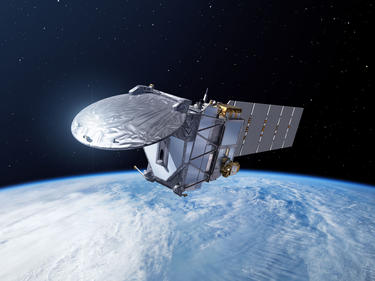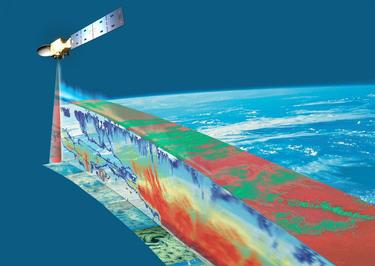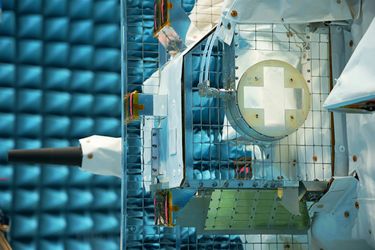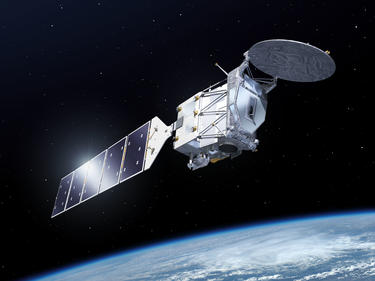EarthCARE is an important new satellite designed and built by Airbus to help scientists better understand climate change on clouds, aerosols and radiation. Under construction for the European Space Agency (ESA), Airbus successfully completed the Electro-Magnetic Compatibility tests in April 2023 and now this latest ESA “Earth Explorer” satellite is getting closer to launch in May 2024.
The impact of climate change is visible everyday on our planet. One of the starkest changes we are experiencing is increasing temperatures.
Although temperature increases can be analysed on the ground, satellite information provides a valuable, complementary source of data that helps refine prediction models. A better understanding of how the different elements that impact our climate interact together is vital. The study of clouds and aerosols - tiny atmospheric particles - is one of them, since clouds are a key regulator of the Earth’s average temperature.
This is where the scientific EarthCARE mission, a joint venture between Europe (ESA) and Japan (the JAXA Japanese space agency), comes in, to quantify the role that clouds and aerosols play in heating and cooling Earth’s atmosphere.

A breakthrough in studying climate change from space
EarthCARE, standing for Earth Clouds, Aerosols and Radiation Explorer, is backed by more than 200 research institutes around the world. Scientists will be able to use the data to create accurate models of cloud development, their behaviour, composition, and interaction with aerosols.
Clouds influence the Earth's energy balance (the balance between incoming energy from the Sun and outgoing energy from the Earth), climate and weather.
Some clouds reflect solar energy back to space, contributing to cooling. Others act as a radiative “blanket”, locking in some of the energy emitted from the Earth’s surface and lower atmosphere and contributing to warming.
In addition, aerosols influence the lifecycle of clouds as they absorb and retain water or become the core of cloud droplets. They contribute indirectly to radiative forcing, quantifying the change in the Earth’s energy budget.
“Predicting temperature variations is really difficult as the models contain a lot of uncertainties and different parameters to take into account,” says Maximilian Sauer, EarthCARE project Leader at Airbus Defence and Space. Cloud systems are complex and because they change and move rapidly, their structure is hard to simulate. “For the first time, EarthCARE will enable us to collect simultaneous observations of cloud and aerosol profiles, together with solar and thermal radiation to enhance climate models.”

EarthCARE will circle Earth in a Sun-synchronous polar orbit crossing the equator in the early afternoon to optimise daylight conditions.The mission will measure the vertical structure and horizontal distribution of cloud and aerosol fields, together with the levels of outgoing radiation.
The computer models being developed will allow more accurate representations of the heating or cooling process happening on our planet. The data will also help scientists to learn more on the interrelationships between clouds and rainfall, their effects on radiation and the balance between clouds’ cooling and warming influences.
Final tests complete on EarthCARE
The EarthCARE satellite, the largest and most complex Earth Explorer to date, will carry four scientific instruments: a lidar and a radar to measure the vertical distribution of clouds and aerosols, an imager to collect cloud and aerosol information across the satellite ground track and a broadband radiometer for measuring outgoing reflected solar and emitted thermal energy at the top of the atmosphere.

After finalising integration in June 2022, EarthCARE was transported from the Airbus site in Friedrichshafen, Germany, to the European Space Agency's ESTEC technology centre in Noordwijk, the Netherlands. There, it was thoroughly tested to make sure it could survive the stresses and strains that occur during launch and the environmental conditions that await it in orbit. In April 2023, it completed its electromagnetic compatibility test to ensure that the electrical and electronic equipment onboard function correctly without disturbing the scientific instruments. With that last month's major milestone achieved, the satellite is now ready for space.
With the new EarthCARE mission, Airbus continues to support scientists to better understand our climate by providing valuable data that will improve current models for climate prediction. Following the Aeolus mission, Airbus keeps pioneering cutting-edge technologies with ATLID, the atmospheric lidar instrument, making the company a worldwide specialist in spaceborne lidar to protect the planet.
Key Facts and Figures
EarthCARE is one of the additional missions launched by the ESA in the Earth Explorer programme dedicated to observing an aspect of Earth’s system.
The EarthCARE mission is to make global observations of clouds, aerosols and radiation.
The mission will carry four scientific instruments: an atmospheric lidar (ATLID), a cloud profiling radar (CPR) supplied by JAXA, a multispectral imager (MSI) and a broad-band radiometer (BBR).
As the European Space Agency (ESA)’s prime contractor, Airbus has developed and built the EarthCARE satellite.
Airbus is responsible for the ATLID instrument and its SSTL subsidiary for the MSI instrument.

